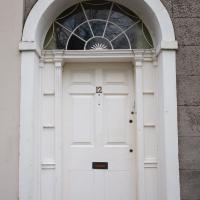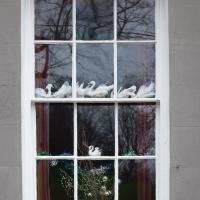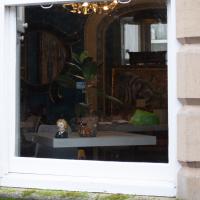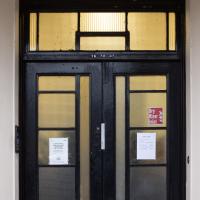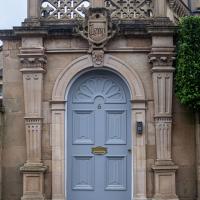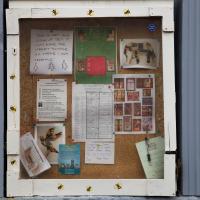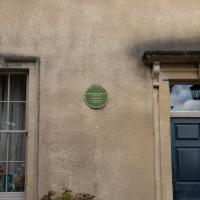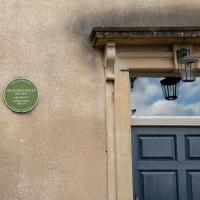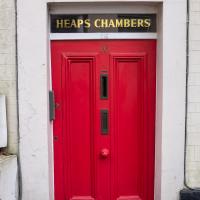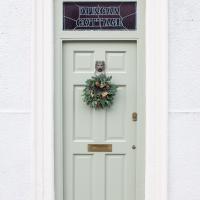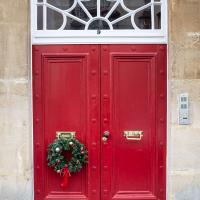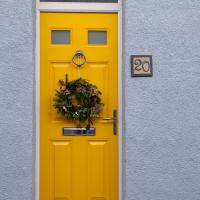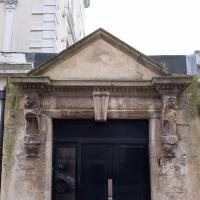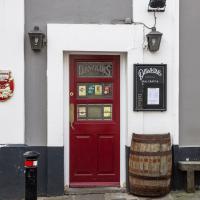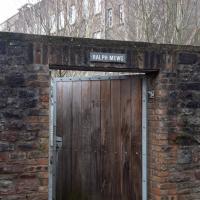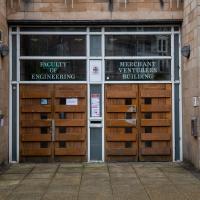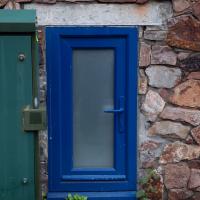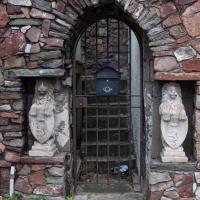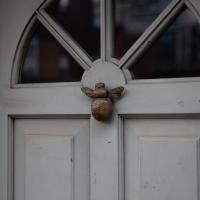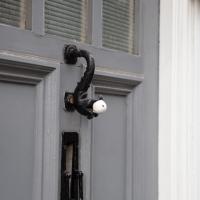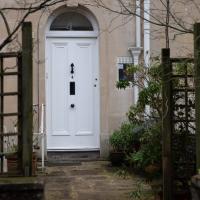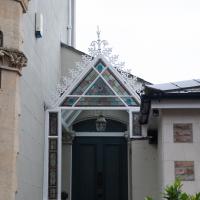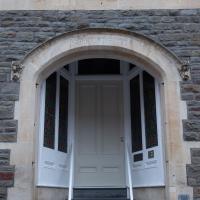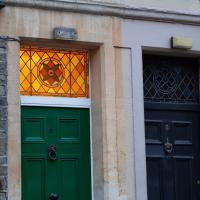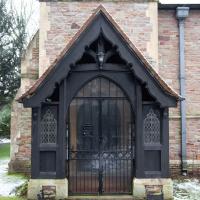Tagged: home-door
Rainy Clifton
13 Dec 2020
A long walk around Cliftonwood and Clifton with my friend Lisa, taking in some of the 12 Days of Christmas display at Queens Parade, picking up a take-away coffee from Pinkmans of Park Street, and poking our heads up against the glass of SS Peter and Paul Catholic Cathedral.
I first thought of Gerald Scarfe, but I think the statuette here looks more like her Spitting Image puppet.
I like Queens Court; apparently it was slung up in 1937 as the first of the large-scale luxury blocks of flats in Bristol. I particularly like the little details like the lettering in the building name and the numbers above the door.
The escutcheon above the door seems to say "Leng". The only Leng I know is the Plateau of Leng mentioned by Lovecraft a few times, first in The Dream-Quest of Unknown Kadath, though I know it best from At the Mountains of Madness. I assume it's not that one.
Supplemental:
After reaching out on Twitter to Tristan Fowler, the only other person I could find who'd researched the motto on the side of the stone walkway between this door and the house (which says "Conflict tests the warrior"), he let me know that it actually says "Leny". Turns out this is Leny House (6 Clifton Park):
attached ashlar gateway to No.6 has a semicircular-arched doorway with panelled surround, between Jacobethan pilasters, and a cartouche inscribed LENY
Cliftonwood and Clifton Village Lunchtime Stroll
14 Dec 2020
The lunchtime walk has been feeling a bit of a chore lately, especially as I only have an hour and have to keep a mental watch out for my "bingo" point or risk being late back. Today I went for a deliberately brief local walk and got home in time to have lunch on my sofa rather than while I was back at work.
It's interesting filling in the gaps in my Clifton Village knowledge, especially starting to "see" the bits I can't see, the negative spaces. The size of both Fosseway Court and the Bishop's House gardens (check out the latter on Google Maps for an idea) are both something I've noticed by just getting to know the areas around them. I may also have to walk into the driveway of the very well-hidden Nuffield hospital to get an idea of how big it is.
None of those are anything compared to the trick of hiding the gargantuan public school that is Queen Elizabeth's Hospital so well that I keep on forgetting it's there, until a glimpse of it from somewhere like Lower Clifton Hill reminds me about it, of course...
Clifton Hill
23 Nov 2020
I've just got to the bit in Fanny Burney's Evelina where our eponymous heroine visit a grand house on Clifton Hill during her stay in Hotwells. It was interesting to wonder if it could be any of the places I passed in my lunchtime jaunt, which took in both Clifton Hill and Lower Clifton Hill.
From Evelina (1778):
"Yes, Ma'am; his Lordship is coming with her. I have had certain information. They are to be at the Honourable Mrs. Beaumont's. She is a relation of my Lord's, and has a very fine house upon Clifton Hill."
Gardens and Cottages
17 Dec 2020
I think the cute little Duncan Cottage was my favourite bit of this wander up the hill to get coffee and a pain-au-raisin from Twelve, though I did enjoy gently musing on the public and private gardens of Clifton, inspired by a closer pass than usual to Royal York Crescent's garden.
I managed absent-mindedly to clear my GPS track before saving it, so this hand-created track-log may cause me problems in the future. I suppose we'll see.
Ususally the cobweb-patterened ones seem to be proper fan-shaped fanlights in Clfiton, so this rectangle caught my eye.
Sunday Bedmo
20 Dec 2020
A long meander around bits of Bedminster, from the river to the north to Winterstoke Road to the south, taking a few roads I've seen before, and a few I haven't. The Christmas decorations were an extra bonus.
I went to have a peep at the giant sinkhole that's opened up in Canynge Square—ironically, having recently discovered the gardens were public I'd had the (triangular!) square on my list to re-visit for a few days, but now there's no entrance to the gardens due to the danger. The area was well fenced-off for safety, but I tried to get a couple of photos from behind the barriers.
I also explored the area around Camp Road, an real melange of architectures, one of the most mixed-up areas I've seen in Clifton, in fact, and confirmed my friend Claire's suspicion that an earlier snap of a sign from Manilla Road was in fact for a fire hydrant. Nice.
"Is this a... gallery?" I asked the man who coincidentally emerged from a door, out of shot to the left.
"No, it’s just someone’s private place that she lets people use, or..." he tailed off, not really knowing how to describe the place.
Prince's Lane
06 Jan 2021
The International Grotto Directory website says:
Prince’s Lane might have been one of the original ancient tracks from Hotwells to Clifton, in the Avon Gorge. The site later formed part of Rownham Woods which comprised some thirteen acres. By the end of the 18th century and the early 19th century, the Society of Merchant Venturers granted to Samuel Powell a building lease, for The Colonnade (1786), St. Vincent’s Parade (1790), Prince’s Buildings (1796), and Rock House. Rock House is generally considered to be the oldest surviving building associated with the Hotwell (see Chapter 20). John Power conveyed part of the woods to William Watts for the construction of Windsor Terrace (1790-1808).
The above development of the Avon Gorge cleared Rownham Woods, and created a triangle of land on the north side of the gorge, that became enclosed as a result, by Mansion Houses, whose garden walls all entered on to Prince’s Lane. The Lane started at the bottom of the gorge, at the base rock of Windsor Terrace, and came out half way up Sion Hill. It is clearly shown as a public footpath, dotted with trees, in Ashmead’s map of 1828. Some of the gardens were quite steep in parts and therefore, had to be terraced, because of the gradient of the gorge.
I've passed Prince's Lane literally thousands of times in my life, every time I've walked past the Avon Gorge Hotel, which itself started (in 1898) as the Grand Clifton Spa and Hydropathic Institution and pumped water up from the Hot Well for its hydropathic treatments. I've never actually ventured down it until today, or at least nothing like as far down it as I did this afternoon—I may have poked my head around the back of the hotel to see the original pump rooms at some point in the past.
This was a great wander, though it does very much feel like a private road, and frankly I may have been pushing my luck a bit by winding my way between the astoundingly big back gardens of the houses of some presumably very wealthy Cliftonites, but I felt vaguely justified in exploring the history of one of the oldest footpaths in my part of Bristol...
This building is 1894, but commemorates the original Hot Well House down in actual Hotwells, built in 1694.
Mirror Maze
10 Jan 2021
Went for a wander with my friend Lisa—the current lockdown rules seem to be that one local walk for exercise per day with a maximum of one person not in one's "bubble" is fine—up to the University of Bristol area right at the edge of my one-mile perimeter to see the Jeppe Hein Mirror Maze, among other things. On the way we mused about Merchant Venturers, the slave and tobacco trades, and dating in the time of Covid.
Interesting to think that if I'd read CS at Bristol rather than Warwick I'd have been doing it in the Merchant Venturers' building. Though I suppose I don't know where Bristol CS was in 1991. Pretty sure they've already knocked the old CS department down at Warwick, but then they always were quite cavalier about the buildings there.
Whenever I see a posthorn, I think of Pynchon's The Crying of Lot 49, but this one isn't muted.
Northern Clifton
16 Jan 2021
A raggedy wander with my friend Lisa, picking up a few stray streets and venturing only briefly onto Whiteladies Road, where it was too damn busy, given the current pandemic. We retreated fairly quickly. Found a couple of interesting back alleys, and got a very pointed "can I help you?" from a man who was working in his garage in one of the rather run-down garage areas behind some posh houses, and clearly didn't want us just wandering around there.
The strangely-hooded entrance of the first house down the identity crisis that is Alma Road Avenue.
Oddly, all the details I can find reference Edgecumbe Hall, not House, but I think it's the same place. Oddly, the listing for this specific gateway doesn't mention the exact name carved on it, but lists it as "GATEWAY ATTACHED TO THORNTON HALL AND EDGECUMBE HALL, RICHMOND HILL".
Snowy Leigh Wander
24 Jan 2021
I started this wander with my "support bubble" Sarah and Vik, after Sarah texted me to say "SNOW!" We parted ways on the towpath and I headed up into the bit of Leigh Woods that's not actually the woods—the village-like part in between Leigh Woods and Ashton Court, where I'd noticed on a map a church I'd not seen before. I found St Mary the Virgin and quite a few other things I'd never experienced, despite having walked nearby them many, many times over many years, including a castellated Victorian water tower that's been turned into a house...
Or is this a narthex? I'm not too up on my church terminology. Anyway. This is the main entrance to St Mary the Virgin, Church Road, Leigh Woods, currently vicared by Rev. Dr Hester Jones, built 1891, designed by John Medland.
As with many pretty things in Bristol, the church was partially funded by money from booze and fags (via the church website):
At 4pm on 1st November 1890 a meeting was called at the home of Mr John Harvey (Harvey’s Wine). A committee of nine men with business acumen and money was formed including Thomas Davey (Franklin Davey Tobacco Co later subsumed into Imperial Tobacco), Mr Edward Swann (an influential solicitor and banker and on very good terms with the Bishop of Bath & Wells), Mr William Garnett, Mr Hoskens Lowe (timber importer) and Mr John Russell Harvey (John Harvey’s son) and Mr E Burrow Hill (the son of Charles Hill, shipbuilder) who became the committee’s secretaries. By the end of the month sufficient funds had been pledged and, with land given by the Leigh Woods Land Company, to proceed to plans.
